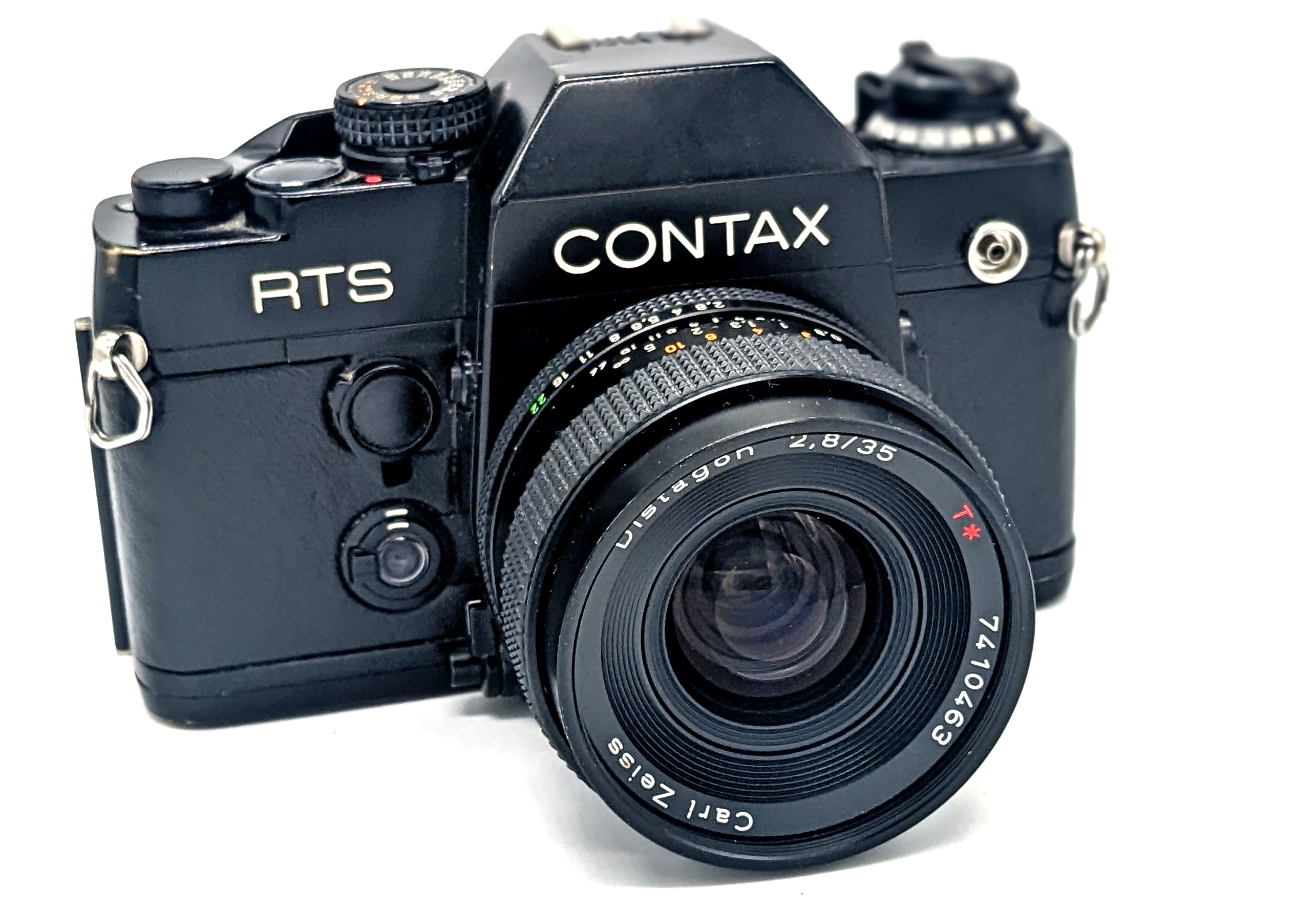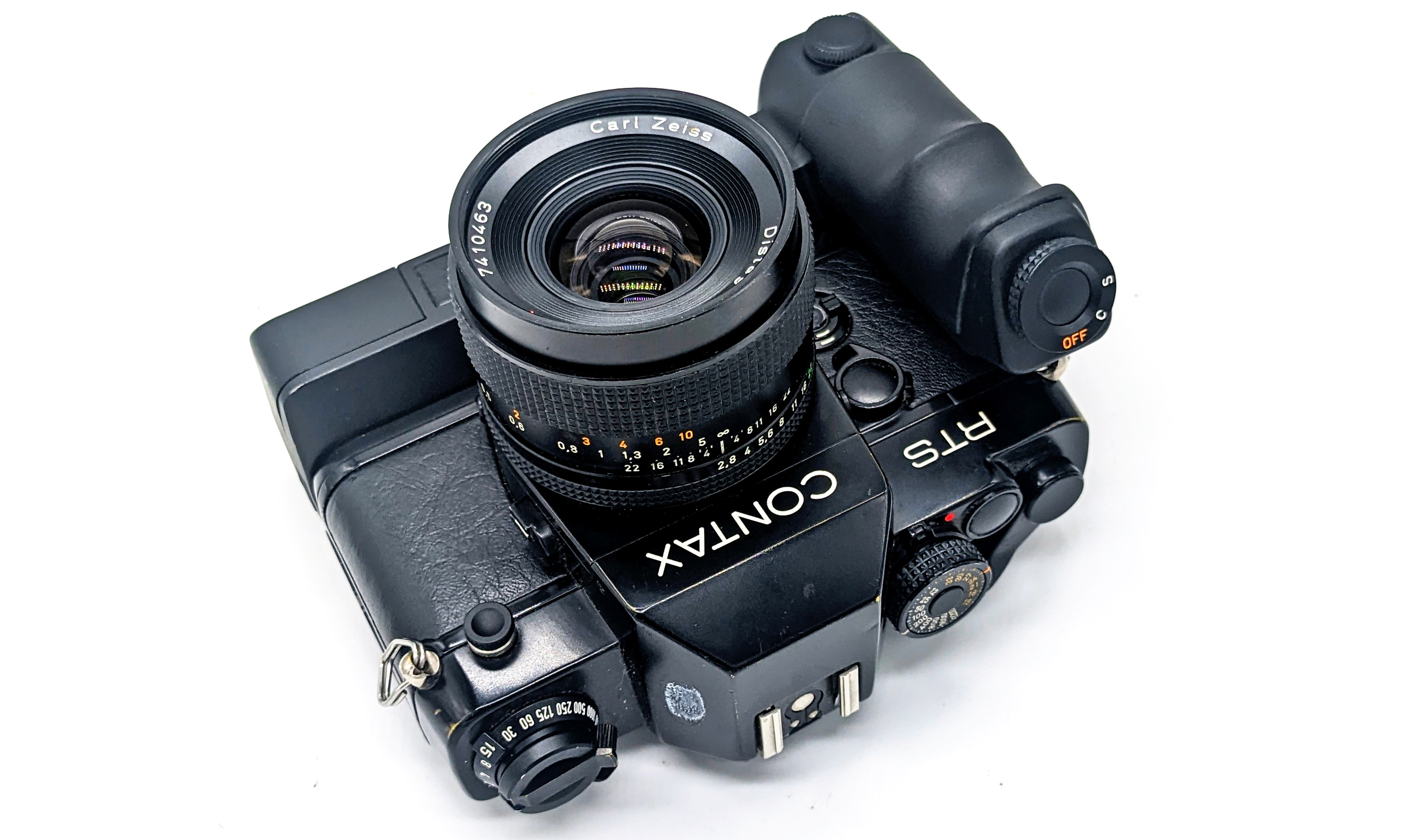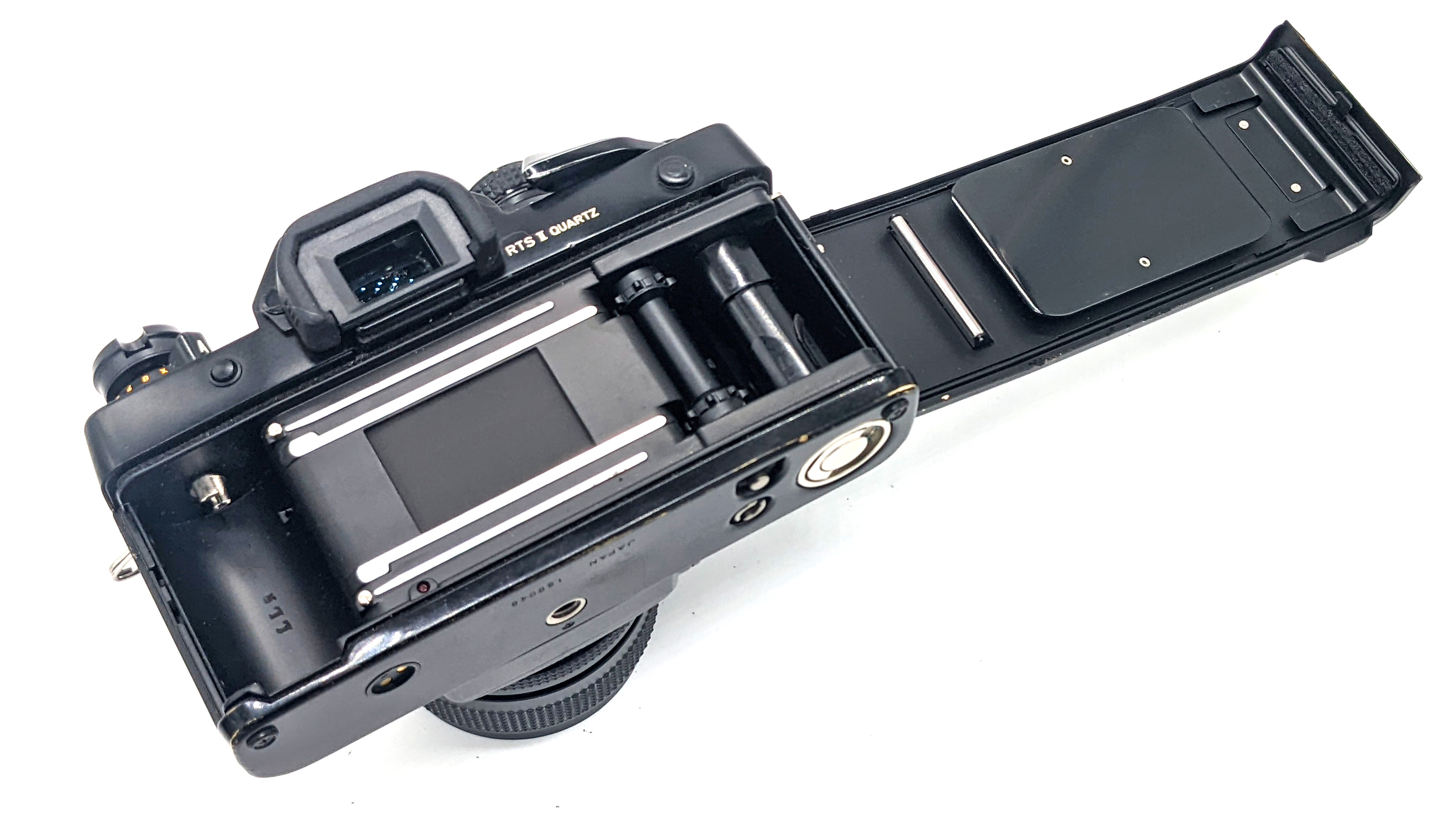
The RTS II was Contax’s flagship professional SLR from 1982 until the introduction of the RTS III in 1990. With pretty much everything you would want in a manual-focus SLR and with a professionally-bright viewfinder, it is an excellent native platform for C/Y-mount lenses.
Sometimes, what separated a 1970s or 1980s professional 35mm SLR from an advanced amateur model was not much. However, professional cameras from this era usually have three significant upgrades over the mid-range: a brighter viewfinder with greater scene coverage and magnification, interchangeable focusing screens, and a higher top shutter speed. Other attributes could include more advanced metering modes, a manual shutter speed backup for electronic shutters, and higher-powered motor drives. With the RTS II, it was not so much that it was more materially capable than the existing prosumer 139Q or 137 MA, but it had a truly professional viewfinder, a slightly higher top shutter speed at 1/2000, interchangeable focusing screens, a manual backup shutter speed, and more robust construction all around. Some of the technology found on the RTS II had already been implemented on the 139, including the capability for TTL flash and a front-mounted exposure lock switch.
The RTS II is certainly the best of what could be considered the “second generation” of Contax-Yashica SLRs, which also included the 139, 137, and Yashica FX-D. The 1986 167MT would be a giant leap forward for Contax, introducing a 1/4000 top shutter speed, multiple program modes, multiple metering modes, integrated film advance and rewind, TTL daylight fill flash, and a number of other truly modern features. Given the fact that so many advanced post-RTS II Contax models exist, some of them remaining very affordable, perhaps there is no compelling reason for most to go “back” to a 1/2000 top speed, only center-weighted metering, and manual everything else?
Marketed as an “upgrade” to the original 1975 RTS, the RTS II retained the ability to use most of the original accessories for the former. Compared to its contemporaries, the 1980 Nikon F3 and the Canon New F-1, it was fairly competitive but not entirely. For instance, the RTS II did not have interchangeable specialized prisms, super high-speed motor drives, and its line up of lenses was not as extensive as either Nikon or Canon. Even by the early 1980s, it appears that Contax had pegged its fortunes not to pros who did niche work like sports or wildlife, but more towards a system that focused on providing capable platforms for high-quality normal focal length (18-200mm) SLR lenses, whereas it can be argued that Nikon and Canon focused on the reverse, high-tech reliable bodies with a ton of accessories and a wider range of above-average lenses.
More than forty years after its introduction, the RTS II remains a highly worthwhile platform, delivering the Contax “experience” without any unnecessary bells and whistles. Let’s take a look.
Specifications
For reference, here are the specifications for three contemporary products: the Leica R4, Contax RTS II, and the Nikon F3.
| Leica R4 | Contax RTS II | Nikon F3 | ||
| Year | 1980 | 1982 | 1980 | |
| 1983 Price (Body Only) | @ $1,000 | @ $500 | @ $400 | |
| Viewfinder Coverage | 92% / .90x | 97% / .87x | 100% / .82x | |
| Viewfinder Info | Shutter Speed / Aperture / Exposure Mode | Shutter Speed / Aperture | Shutter Speed / Aperture | |
| Focusing Screens | Interchangeable (5) | Interchangeable (8) | Interchangeable (21) | |
| Shutter Speeds | 1 sec – 1/1000 | 16 sec – 1/2000 | 8 sec – 1/2000 | |
| Shutter Type | Vertical Metal | Horizontal Titanium Foil | Horizontal Titanium Foil | |
| ASA Range | 12-3200 | 12-3200 | 12-6400 | |
| Exposure Modes | P / A / S / M | A / M | A / M | |
| Exposure Lock? | Yes | Yes | Yes | |
| Metering | Center Weighted / Spot | Center Weighted | Center Weighted | |
| X-Sync | 1/100 | 1/60 | 1/80 | |
| TTL Flash? | No | Yes | Yes | |
| DOF Preview? | Yes | Yes | Yes | |
| Backup Speed | 1/100 | 1/50 | 1/60 | |
| Winder | External | External | External | |
| Winder Model | Motor-Winder or Motor-Drive | W-6 or W-3 | MD-4 | |
| Exposure Comp. | Yes | Yes | Yes | |
| Prisms | Fixed | Fixed | At Least 6 | |
| Batteries | 2 x SR44 | 1 x S28PX | 2 x SR44 | |
| Weight | 635g | 735g | 715g |

Operation
Viewfinder: The RTS II uses a different viewfinder than those employed in the contemporary 139 and 137 MA (95% / 0.86x) and is also different than those used in the later 159 and 167MT. 97% viewfinder coverage with a .87x magnification is a professional specification. Curiously, the RTS II stock focusing screen is a microprism type that lacks a split screen focusing aid. The viewfinder displays both the shutter speed and aperture but lacks the frame count that was included on the 137 MA. The viewfinder is noticeably brighter that the 139 and 137 (which are both fairly bright themselves). Unlike, the 139 / 137, which displays the selected aperture at the bottom of the viewfinder via some kind of magnified reflected dial, the RTS II uses LEDs to display the aperture, even in half-stops, even with Yashica ML lenses.
Exposure Modes: The RTS II is aperture-priority, which means that the camera selects the appropriate shutter speed given the selected aperture. It also has the capability for metered manual, which means that an LED will blink at the correct shutter speed given the selected aperture. Metering and taking a shot is a little unusual and works the same way as the 139, 137, and FX-D. With the shutter not cocked, metering of the scene is performed by either pressing the shutter button or the button of the front lever. However, if the shutter is cocked, pressing the release will take a photo without any preview opportunity. If the shutter is cocked, you must use the front button to take a pre-exposure reading.
Manual Back-Up Speed: Obviously, a concession to professionals who still probably lacked confidence in batteries and electronic shutters, the 1/50 backup manual shutter speed is activated by turning a lever and then pressing the DOF preview lever.
Battery: The RTS II uses a single 6V battery The silver oxide versions include the S28PX and the 4SR44. The alkaline version is the A544.
Exposure Lock Lever: Introduced on the 139, and also used on the 137 and the Yashica FX-D but disappearing on the 159, the RTS II has a front-mounted exposure check and lock lever. Pressing in the button checks the exposure. Turning the lever will “lock” the current exposure reading indefinitely until the lever is switched back. With some practice, this system is almost as convenient as the more conventional “half-press” of the shutter speed button found on other manufacturers’ products.
Internal Improvements: Over the original RTS, other than some better technology, Contax implemented a better film pressure plate and improved the film transport system.
Film Loading: The RTS II employs a little sleeve in the spool to take up the film leader, ala the Leica M3 or Leica CL. When loading the film, the camera will automatically set itself to 1/60 for shooting the blank frames to arrive at frame 1. I have found that loading film in an RTS II can be a little finicky because the sleeves sometimes do not hold the film leader well, perhaps because over time they have lost their snugness or maybe modern film stocks are a bit thinner.
Other Functions: The RTS II has the standard series of other features which do not require any detailed explanation: a 1/2000 top shutter speed, a shutter lock switch, DOF preview, exposure compensation dial, conventional manual film loading and rewind, capability for double exposures, and self-timer.

Accessories
Flashes: The RTS II has a relatively slow flash sync speed of 1/60. Its hot shoe contains two pins and can fully utilize the entire range of Contax TTL-capable flashes. In my opinion, the RTS II pairs the best with the affordable TLA 30. While not a small unit, the TLA 30 has native bounce abilities and can use TTL flash exposure with any aperture set on the AE lens, allowing a sort of primitive daylight fill operation.
Focusing Screens: Contax produced a total of eight (8) focusing screens for the RTS II. Unfortunately, these screens are not compatible with any subsequent Contax model. The split image focusing screens are extremely hard to find these days.
Winder: Contax produced two professional winders compatible with the RTS II: the W-6 and the W-3. The hefty W-6 plus its 12-AA battery powerback was carryover from the original RTS and can shoot up to five frames per second and features some interval shooting settings. Also offered was the more compact W-3 with a three frames per second capability that took only 6 AA batteries.
D-4 Databack: Designed for some specific practical use that seems to be unknown today, the RTS II had an optional databack that could imprint the time, date, and frame number on the negative.
Eyepiece: For some reason, the OEM Contax rubber eyepieces are a little hard to come by. Fortunately, as with nearly every single Contax and Yashica SLR, the cheap replacements for various digital Canon SLRs fit just fine.
Conclusions
If looking at pre-1985 Contax SLR models, I would recommend the RTS II over any alternative (coming in second would be the 137 MA). If looking at models like the Leica R3-R5, the problem with Leica R for film use is that the lenses have skyrocketed in price, almost absurdly so. When comparing the RTS II to the Nikon F3 or Canon New F-1, it may come down to your preference between great bodies and great lenses. When comparing the RTS II to any other pre-1985 non-professional, manual-advance camera, the RTS II will pretty much always be the better choice.
A review very much worth reading – thank you David!
I myself have been using RTS IIs since the mid-80s, and Canon New F-1s for several years.
Both have their strengths and weaknesses:
The Canon New F-1 is a real professional camera that I can use in the cold, rain and snow. I would only use the RTS II there with external battery magazines (P-3). And I’m not sure whether the RTS II is as weatherproof as the New F-1. With its modular system (including different modes for exposure metering), the New F-1 is wonderfully variable and adaptable. And, of course, the body is a TANK.
The RTS II, on the other hand, with its extremely fast shutter release button, is the perfect action camera – much faster than the New F-1. Though the Canon Motor Drive FN and the Contax Motor Drive W-6 are equally fast. The Contax TLA flash system was state of the art in the 80s (much more advanced than Canon’s) and is still easy to use today. Above all, the digital RTS II viewfinder displays are fully legible even in pitch darkness – in this respect it is far superior even to the New F-1 and also the Nikon F3.
Thanks! Those are some very good and useful observations!